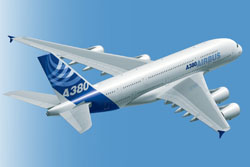
Posted to News on 20th Jan 2007, 17:24
SKF helps Airbus get A380 off the ground
Several of the latest technologies from SKF are playing an important role in the development of the world's largest passenger aircraft, the Airbus A380.

The design of the new Airbus A380 is pushing the boundaries of engineering technology and is one of the most challenging engineering projects that has been undertaken in the civil aviation sector in recent years. Most importantly, SKF is helping Airbus to reduce the overall weight of the new aircraft while ensuring cost-efficiency and maximum capacity.
To help in achieving these goals, as well as meeting the stringent safety and performance requirements for the new super-carrier, Airbus appointed SKF to provide a wide range of products including: rods and structures for structural and flight control applications; ball, roller and spherical plain bearings for landing gear, flight controls and engine links; and mechatronics, including position and force transducers; and linear and rotary actuators.
The challenging requirements of the Airbus 380 resulted in the adoption of many new materials in place of the traditional options of aluminium and steel. For example, SKF developed struts, which are used in the wing boxes, manufactured from composite materials using a resin transfer moulding process. These were supplied in the form of a kit comprising the 143 struts, each around 2.5m in length, along with over 3000 bolts and ancillary components that were required for the construction of the wing box. The use of these materials has allowed the weight of the A380 wing boxes to be reduced by as much as 40 per cent compared with those constructed using conventional materials.
In addition, SKF developed and manufactured a new range of lightweight titanium bearings specifically for use in landing gear, pylon attachments and wing assemblies. During the development of these bearings, SKF engineers tested dozens of different material combinations and, in the early stages, were not even certain if titanium could be a feasible material option. The key to producing a viable bearing is the development of a coating to prevent galling, a severe form of adhesive wear that can occur during sliding contact between two surfaces. This is a particular problem with titanium, which has a relatively high coefficient of surface friction combined with low tensile and shear strength. In addition, titanium is prone to oxidation, with the oxide formed as a surface layer that is transferred to the sliding surface, producing wear debris. SKF developed a solution to these problems using two different coatings to eliminate the galling issue and make possible the titanium-to-titanium contact needed for the self-aligning function of the bearings.
For the landing gear of the Airbus A380, twelve of the self-aligning spherical bearings, with bronze bushings, were used per aircraft to provide structural attachments between the landing gear and the fuselage, and to facilitate the rotation of the support pivot axis. This cutting-edge application resulted in weight savings of over 100Kg, compared with the use of traditional bi-metal bronze-and-steel bearings.
SKF bearings are also being used in the horizontal tail plane system, which enables the tail of the Airbus A380 to be adjusted from +2degrees to –10degrees to maintain aircraft stability. The system comprises a bearing assembly that provides the hinge and attachment points for the trimmable horizontal stabiliser, which controls the pitch of the aircraft.
An SKF high-performance actuator controls the rotation of the hinge to adjust the angle of the horizontal stabiliser so as to trim out any deflection of the elevator in response to commands from the pilot or the autopilot. The horizontal stabiliser pivots on two spherical plain bearings. Furthermore, the bearing assembly includes a fail-safe hinge and a metal-to-metal spherical plain bearing, while the main body of the hinge is made from anodised titanium to protect against galvanic corrosion.
This innovative assembly has been specifically designed and tested to withstand high compressive radial and tensile axial loads, as well as the fatigue produced by these loads. In addition, as the horizontal tail plane plays a vital role in the stability and safety of the aircraft, SKF's engineers developed a fail-safe design that provides a dual load path for both the hinge assembly and the spherical bearing.
SKF also supplied the mainshaft and gearbox bearings for both of the A380's 70,000lb thrust engine, the Rolls Royce Trent 900, and the Engine Alliance (General Electric and Pratt and Whitney) GP7200. Using designs based on revolutionary integrated mainshaft bearings, SKF allowed Airbus to reduce the weight, cost and number of components used in the engines.
For the flight controls of the Airbus A380, SKF supplied state-of-the-art fly-by-wire systems based on the pioneering technology developed by the company for the highly successful Airbus A320. These systems provide the vital link between the pilot and the flight-control computers.
Gilles Labouret, Aerospace Marketing Manager for SKF states: "The decision to appoint SKF was based on our proven expertise in the sector, our wide range of products designed specifically for aviation applications and our engineering resources."






























